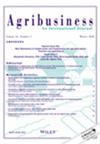"生物塑料?嗯,我从没见过!"--消费者对新鲜苹果和西红柿不同包装材料偏好的混合方法调查
IF 2
3区 经济学
Q2 AGRICULTURAL ECONOMICS & POLICY
引用次数: 0
摘要
新鲜水果和蔬菜的包装是许多杂货店的标准配置。这项混合方法研究旨在确定包装在消费者选择中扮演的角色,以及消费者更喜欢哪种包装材料。我们对来自定量陈述偏好实验的数据进行了分析,实验样本为居住在德国的 485 名消费者。除实验外,我们还进行了一项定性研究,分析了 13 位参与 "大声思考 "协议并回答开放式问题的消费者的数据。我们分别分析了定量研究和定性研究的数据,然后系统地比较了它们的主要发现。基于选择的联合分析表明,包装在消费者决策中的重要性低于价格和产地,但消费者显然更喜欢无包装的农产品,而不是有包装的农产品。苹果和西红柿都是如此,前者是相对坚固的农产品,后者则更容易受损。定性研究表明,消费者欣赏看到和选择无包装产品的能力,但也看到了包装的一些好处,如对农产品的保护。总之,我们发现,通过将定性和定量研究相结合,我们能够发现消费者对新鲜农产品包装的偏好既有重叠,也有不同的方面。关于在生鲜产品中使用生物基塑料,我们的研究结果表明,德国消费者目前并不倾向于选择这种类型的包装,而且有证据表明,他们对此知之甚少和/或认识不足。我们的研究结果对研究人员、营销从业人员、包装生产商和政策制定者都有借鉴意义。[经济学引文:D12, Q50]。本文章由计算机程序翻译,如有差异,请以英文原文为准。
“Bio‐based Plastic? Hm, I've Never Seen It!”—A mixed‐methods investigation into consumer preferences for different packaging material of fresh apples and tomatoes
Packaging of fresh fruits and vegetables is standard in many grocery stores. This mixed methods study aims to identify the role packaging plays in consumer choice and what packaging material consumers prefer. We analyzed data from quantitative stated preference experiments with a quota sample of 485 consumers living in Germany. In addition to the experiments, we conducted a qualitative study and analyzed data from 13 consumers who participated in think aloud protocols and responded to open‐ended questions. We analyzed the data from the quantitative and qualitative studies separately and then systematically compared their key findings. Choice‐based conjoint analyses showed that packaging was less important than price and origin in consumers' decisions, but that consumers clearly preferred unpackaged to packaged produce. This is true for both apples, a relatively robust produce, and tomatoes, which are more susceptible to damage. The qualitative research indicated that consumers appreciate the ability to see and choose an unpackaged product, but also see some benefits of packaging, such as the protection of the produce. Overall, we found that by combining qualitative and quantitative insights, we were able to identify overlapping but also distinct facets of consumer preference for fresh produce packaging. Regarding the use of bio‐based plastics for fresh produce, our results indicate that German consumers were not currently inclined to choose this type of packaging, and evidence suggests that they have little knowledge and/or awareness about it. Our findings have implications for researchers, marketing practitioners, packaging manufacturers, and policy makers. [EconLit Citations: D12, Q50].
求助全文
通过发布文献求助,成功后即可免费获取论文全文。
去求助
来源期刊

Agribusiness
农林科学-食品科技
CiteScore
5.50
自引率
6.20%
发文量
58
审稿时长
6 months
期刊介绍:
Agribusiness: An International Journal publishes research that improves our understanding of how food systems work, how they are evolving, and how public and/or private actions affect the performance of the global agro-industrial complex. The journal focuses on the application of economic analysis to the organization and performance of firms and markets in industrial food systems. Subject matter areas include supply and demand analysis, industrial organization analysis, price and trade analysis, marketing, finance, and public policy analysis. International, cross-country comparative, and within-country studies are welcome. To facilitate research the journal’s Forum section, on an intermittent basis, offers commentary and reports on business policy issues.
 求助内容:
求助内容: 应助结果提醒方式:
应助结果提醒方式:


